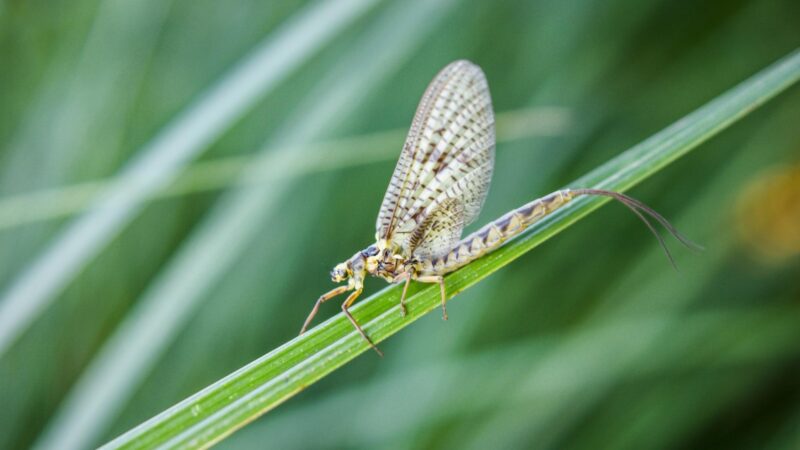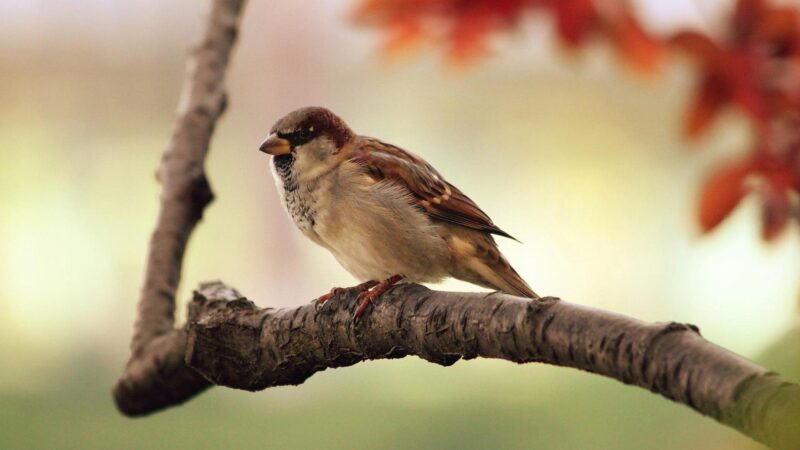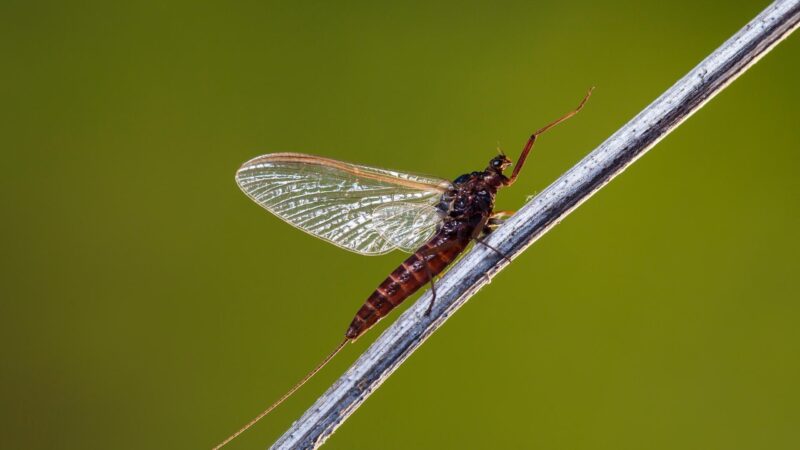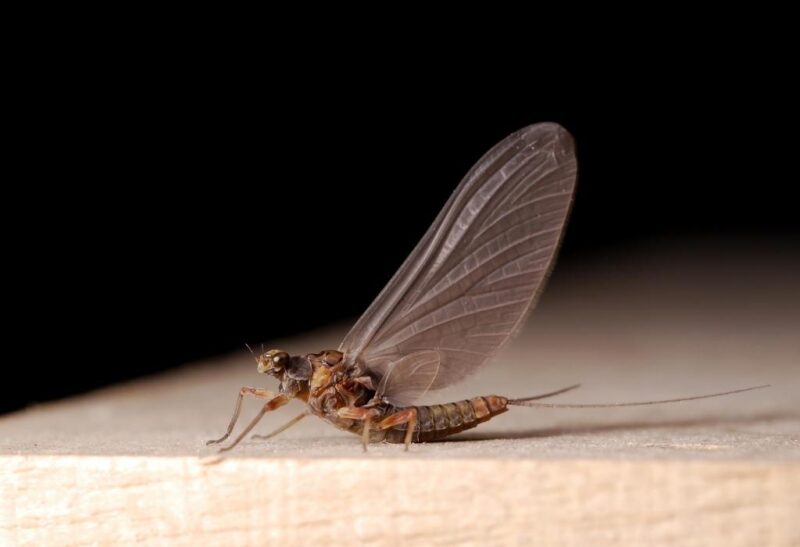You may have seen mayflies when you go on a hike along woodland or forest streams on a beautiful spring day. They are usually easy to spot as they form swarms in midair, which is known as a mating dance between males and females.
Mayflies are winged insects that spend almost all their lives underwater. Larvae live for up to a year but once it become an adult it lives only for a day or two.
Adult mayflies have bodies that are elongated and slender, with antennae, two to three long tails, and shiny triangular wings. They lack functional mouthparts and lose the hair on their wings as they become full-fledged adults.
To know more about mayflies, what they eat, where they live, the ecological functions they serve, what attracts them and prompts them to form swarms, and other interesting information, read this article for more!
Table of Contents
What Are Mayflies?

Mayflies are tiny winged, aquatic insects usually found along woodland streams during the spring season, just as the sun begins to fade. They are also referred to as fishflies, willowflies, shadflies, and up-winged flies.
They belong to the order Ephemeroptera which are winged insects that lack wing articulations or joints that allow them to fold their wings back over their abdomens—a trait that is considered primitive and is thought to be present in the first flying insects. In fact, fossil evidence reveals that mayflies have been around from 290 to 354 million years ago.
What Do Mayflies Look Like?
The following are the physical descriptions of mayflies at different stages of their life cycle:
Nymph (Larva)
Nymphs are less than a millimeter long when they first hatch but can grow from 4 millimeters to 3 centimeters in length as they develop. They will also develop leafy gills and short, hair-like tails in the later periods of their nymph stage.
Their body shapes vary depending on the habitat and genus: burrowing mayflies (Ephemera) are more cylindrical, while mayflies that slide under rocks (Heptagenia) have flatter bodies, and mayflies that crawl on vegetation and mossy stones (Caenis) have shorter bodies with squat legs.
Subimago (First Flying Stage)
Females have smaller eyes and oviducts found on their lower abdomen, while males have clasping organs that serve reproductive functions. Both sexes will have dull but pigmented wings as well as short hairs on their wings and body. Their six legs and tails will also grow more in length.
Imago (Final Adult Stage)
Fully adult mayflies have elongated and slender bodies with antennae and two tails that are either half or more than their entire body length. Some species may have three tails due to an extra abdominal filament. Additionally, they lose their mouthparts and the hair on their wings, which result in shiny and triangular-shaped wings.
What Do Mayflies Eat?
Adult mayflies lack mouthparts. Thus, they are not able to eat anything. Mayfly nymphs, on the other hand, are considered opportunistic generalists who are not selective when choosing what to eat. They usually consume algae, detritus, sediments, and other plant materials that are available in their habitats.
Do Mayflies Eat Mosquitoes?
Mayflies do not eat mosquitoes. Mayfly nymphs are primarily herbivorous and spend nearly most of their lifespan underwater.
What Eats Mayflies?

Mayfly eggs are eaten by caddisfly larvae and snails, while nymphs and subimagos are predated by fish, flies, frogs, birds, and predatory insects such as water beetles, leeches, alderflies, stoneflies, and dragonflies. Lastly, adult mayflies are eaten by birds, spiders, bats, shrews, and winged insects such as damselflies and dragonflies.
Where Do Mayflies Live?
Immature mayflies also referred to as naiads, are microhabitat specialists. Each different species thrive on specific environmental conditions that include substrate type, depth underwater, and amount of wave action.
They usually develop in well-oxygenated and unpolluted streams, rivers, and lakes as they have external gills that make them vulnerable to pollution and silting.
Furthermore, naiads are classified by their modes of locomotion which will also define their habitats. They can be climbers, burrowers, clingers, sprawlers, swimmers, and crawlers. This means, depending on the species, naiads can live on the bottom of the body of water, under rocks, in tunnels, at specific depths, or on decaying submerged vegetation.
Meanwhile, adults inhabit the edges of the wetlands they were born in since they only live for a short period of time. They prefer living in and laying eggs in freshwater environments.
When Do Mayflies Hatch?

The time mayfly eggs take to hatch ranges from as fast as ten days to as slow as many weeks and months. It depends on the environmental conditions they live in as well as the species.
A copulation between male and female mayflies is brief wherein the male will form dense clouds in the air and the water, then the females will fly in, joining them, and mate.
Female mayflies can lay around 500 to 3,000 eggs singly, in batches, or all at once. They place the eggs onto or under the water’s surface during flight or while perching on top of a rock. Some species, such as those belonging to the family Ephemerellidae, would crawl underwater to deposit their eggs.
What Is the Purpose of Mayflies?
Mayflies serve a variety of essential ecological purposes, such as:
- They are used as parameters for regulating water quality. Their presence and diversity in bodies of water can be used as indicators of the health of their associated aquatic environments.
- They are important links in the ecosystem of freshwater habitats as they produce energy that is stored in algae and other aquatic plants. Afterward, they will be eaten by their predators and a healthy food web within the ecosystem is established.
- They are used as food for gamefish, such as trout, salmon, and rock bass. They are also used as models for tying flies on fishing rods.
- The documentation and research of mayflies are important for the understanding of their biodiversity, distribution, and genetic makeup. This will also help scientists and biologists understand recently extinct species such as the Isonychia diversa, Siphlonurus luridipennis, Ephemera compar, and Pentagenia robusta.
When Do Mayflies Come Out?

The emergence of adult mayflies usually occurs in June, July, and August. However, they can emerge anytime around late spring to early fall. This is also the time they mate and lay eggs. When adults and newly full-fledged adults enter the land, their populations are large enough to disturb outdoor activities.
What Causes Mayflies to Swarm?
Mayflies swarm during courtship and mating where males can be seen fluttering their translucent wings in a dance midair to find potential mates. These swarms are called mating aggregations and can form extremely dense clouds in the air near bodies of freshwater, to the extent that their large concentrations could be detected using Doppler radar weather maps.
Swarms usually last from 1 and a half hours to 2 hours in the early morning and are found 1 to 4 meters above ground or water.
What Attracts Mayflies?
In nature, mayflies are attracted to the reflection of bodies of water. However, they are attracted to lights in general and more so during nighttime.
Do Mayflies Bite or Sting?

Adult mayflies lack both mouthparts for biting as well as specialized stingers for stinging. Hence, they cannot hurt any humans. Even though naids have mouthparts they can use to chew food, it is not sturdy enough to bite through human skin. Additionally, they live underwater, so human mayfly naiad interactions are rare.
Do Mayflies Bite Dogs?
Mayflies do not bite dogs. Adult mayflies have no functional mouthparts they can use for biting, and naiads cannot bite hard enough onto dog skin.
How to Get Rid of Mayflies Naturally?
Adult mayflies do not live very long outside of their habitats, but if they happen to survive long enough to land in your garden or yard, here are the things you can do to get rid of them naturally:
- If you have a pond or a pool, cover them with a pool cover, wood, and other applicable materials and products to prevent mayflies from inhabiting them.
- Place mayfly predators into or near the pond or pool water. This includes dragonflies, water beetles, and leeches.
- Control the growth of algae in your pond. If you have a pool instead, regularly sanitate it to avoid bacteria growing in it.
How to Get Rid of Mayflies Outside?
Turn off any lights and light sources you have outside at night to reduce mayfly swarms. Relocate them if you can. You can also choose to place electric insect zappers next to your lights and light sources to immediately kill or at least paralyze mayflies.
How to Kill Mayflies?
Introducing their natural predators into their habitats can help control their populations when their swarms have become a nuisance. You can also use chemical control, such as pesticides to kill them. However, it is not advised to kill mayflies as they serve essential ecological roles in freshwater ecosystems.
Why Are Mayflies Called Mayflies?
It references the abundant and most well-known mayfly species, the Ephemera danica or the green drake mayfly, which emerges as full-fledged adults when the Mayflower is in bloom.
Moreover, mayflies are the common name of the order Ephemeroptera, which according to its entomology, is derived from the Greek word ephemera, meaning short-lived, and ptera, meaning wings. This is an apt scientific name for adult mayflies as they only live for short periods of time.
How to Keep Mayflies From Biting?
Although mayflies may be nuisance pests during mating and their numbers could get a little intimidating, they cannot bite humans nor harm them in any way possible, so you do not have to worry about them.
Mayflies are aquatic, winged insects found in freshwater environments that are well-oxygenated and unpolluted. They live nearly their entire lifespan underwater as they hatch from eggs until they emerge as full-fledged adults. They may become a nuisance when they form swarms in midair during mating seasons. However, it is not recommended to remove them as they serve essential ecological purposes.
List of Sources
Incredible Mayfly Facts! University of Wisconsin–La Crosse – Bioweb.
Huskinson, D. Mayflies Love Healthy Streams. Smithsonian Science Education Center.
Embrace the Mayfly (It may soon be what’s for dinner). (2018). Millerville University.
Mayflies. Missouri Department of Conservation.
Newton, B. (2004). Mayflies. University of Kentucky Department of Entomology.
